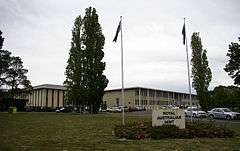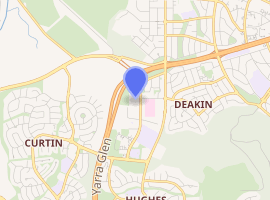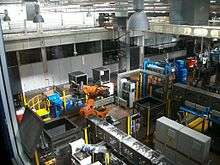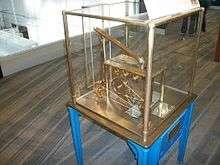Royal Australian Mint
The Royal Australian Mint is the sole producer of all of Australia's circulating coins. Opened in 1965 and situated in the Australian federal capital city of Canberra, in the suburb of Deakin, the Mint is also a very popular tourist destination for visitors and locals alike.
| Royal Australian Mint | |
|---|---|
 | |
 Royal Australian Mint | |

| |
| General information | |
| Location | Canberra, Australia |
| Opened | 22 February 1965 |
| Website | |
| https://www.ramint.gov.au/ | |
Before the opening of the Australian mint, Australian coins were struck at branches of the Royal Mint - the Sydney Mint, Melbourne Mint and Perth Mint. The Royal Australian Mint is the first mint in Australia not to be a branch of the Royal Mint in London. The only other operational mint in Australia is the Perth Mint.
Foundations and history
Planning for the mint started in 1959 when it was proposed to move the Royal Mint branch in Melbourne to Canberra. It was officially opened by The Duke of Edinburgh on 22 February 1965, coinciding with decimal currency, which was introduced into circulation on 14 February 1966. The new mint cost A$5 million to build, with an additional $4 million for equipment.
The new mint and the Melbourne Mint operated concurrently while sufficient stockpiles of new coinage were prepared and until it was felt that production in Canberra was proceeding smoothly, after which in 1967 the Melbourne mint was closed. Some staff from the Melbourne mint relocated to Canberra to operate the new mint. However it was not until the early 1980s that the RAM was able to sustain solitary production of the full set of circulating Australian coins, and so on several occasions in the 1960s and 1970s the RAM contracted production runs to the Perth Mint, the Royal Mint in both London and Llantrisant, and even on one occasion the Royal Canadian Mint.
The mint consists of two buildings, an administration building, and a process building. The administration building houses the engravers, a laboratory, and a vibration-free basement where coinage is measured to ensure correct size and weight.[1]
The mint is an Australian Public Service agency, staffed through the Department of the Treasury.[2]
During 1984-1986 renovations were carried out to support the increasing demand for the production of collector coins, and also to improve the visitor facilities. Visitors can mint their own legal tender coin using visitor presses.

The mint serves primarily to manufacture Australia's legal tender precious metal coins. Notes are produced by Note Printing Australia in Melbourne. The mint also produces medals for military and civilian honours, most notably the Order of Australia. The mint produced medals for the 2000 Summer Olympics in conjunction with the Perth Mint. The Royal Australian Mint also produces tokens made for commercial organisations such as casinos, car washes etc.
Since its opening, the mint has produced over fifteen billion coins and has the capacity to produce two million coins per day.[3] Coins have also been struck for several Asian and South Pacific nations, including New Zealand (in 1969), Papua New Guinea, Tonga, Western Samoa, the Cook Islands, Fiji, Malaysia, Thailand, Nepal, Bangladesh, Israel, and the Philippines.

In November 2001, the mint issued the world's first coin with a double hologram, to commemorate the centenary of Australian federation. The mint also creates bi-metallic coins, and colour printed coins.[4]
On 11 December 2005 the Joint Standing Committee on Public Works tabled a report recommending the refurbishment of the Royal Australian Mint with a projected cost of A$41.2 million. Work was planned to commence in October 2006 with completion dates of June 2008 for the process building, and April 2009 for the administration building.[5]
The refurbishment also planned to introduce industrial robots to the manufacturing process.[6] The work was completed in 2009, and the mint is now open to the public.[7]
In 2014, the Abbott Government announced a scoping study into selling the Royal Australian Mint.[8]
See also
References
- Pearce, Steve (2001). Making money, the story of the Royal Australian Mint. Nucolorvue Productions (www.nucolorvue.com.au) ISBN 0-85858-155-8
- Chart of 109 Agencies under the Financial Management and Accountability Act 1997 (FMA Act) (PDF), Department of Finance, 1 January 2014, archived from the original (PDF) on 4 March 2014
- "About the mint". Royal Australian Mint. Retrieved 5 October 2014.
- "Royal Australian Mint Issue 45" (PDF).
- Joint Standing Committee on Public Works - Proposed Refurbishment of the Royal Australian Mint Building, Canberra - Report Archived 13 January 2006 at the Wayback Machine
- Royal Australian Mint press release - Australian company to modernise Mint with robots
- Royal Australian Mint FAQ: About the Mint: I would like to visit the Mint. What can I expect to see?
- Gareth Hutchen (28 May 2014). "Abbott government rules out privatisation of Australia Post". Sydney Morning Herald. Retrieved 4 October 2014.
External links
| Wikimedia Commons has media related to Royal Australian Mint. |